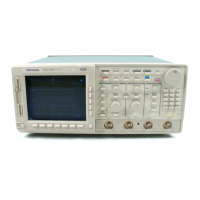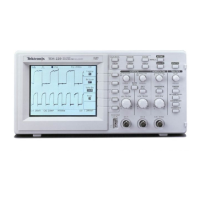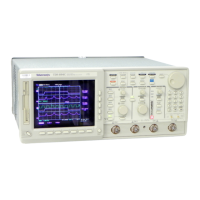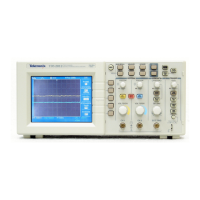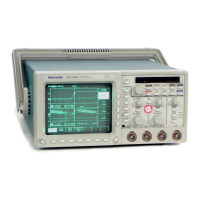Typical Characteristics
1–28
TDS 500B, 600B and TDS 700A Service Manual
Table 1–16: Typical Characteristics — Triggering System (Cont.)
Name Description
Width, Minimum Pulse and Rearm, for
Logic Triggering or Events Delay
For vertical settings > 10 mV/div and ≤ 1 V/div at the BNC input
Triggering Type
Minimum Pulse
Width
Minimum Re-Arm
Width
Minimum
Time Between
Channels
7
Logic Not Applicable 1 ns 1 ns
Events Delay 1 ns (for either + or
– pulse widths)
Not Applicable 2 ns
W
d
,
n
u
Pu
nd
r
, f
r
For vertical settings > 10 mV/div. and 3 1 V/div at the BNC input
Pu
Tr
r
n
T
n
u
pu
w
d
nd r
r
m
i ths a t a sitio times
8
eieo
Pulse Class
Minimum Pulse
Width
Minimum Re-Arm Width
he mi im m lse i ths a ea m
widths and transition times
required for
Glitch 1 ns 2 ns + 5% of Glitch Width Setting
Pu
-T
p
r
r
n
.
Runt
2 ns 2 ns
Time-Qualified Runt 2 ns TDS 600B: 7 ns + 5% of Width Setting
TDS 700A: 8.5 ns + 5% of Width Setting
Width 1 ns 2 ns + 5% of Width Upper Limit Setting
Timeout 1 ns 2 ns + 5% of Width Upper Limit Setting
Slew Rate 600 ps
8
TDS 600B: 7 ns + 5% of Delta Time Setting
TDS 700A: 8.5 ns + 5% of Delta Time
Setting
Input Signal Sync Amplitude for Stable
Triggering, HDTV and FLEXFMT modes
(Option 05 Video Trigger)
All field selections: 0.6 division to 4 divisions
Jitter for HDTV mode
(Option 05 Video Trigger)
17 ns
p-p
Sync Width Flex Format and HDTV
modes (Option 05 Video Trigger)
min. 400 ns
Sync Duty Cycle, Flex Format and HDTV
modes (Option 05 Video Trigger)
min. 50 to 1
Hum Rejection
(Option 05 Video Trigger)
NTSC and PAL: –20 dB without any trigger spec deterioration. Triggering will continue
down to 0 dB with some performance deterioration.
1
The trigger position errors are typically less than the values given here. These values are for triggering signals having a
slew rate at the trigger point of ≥ 0.5 division/ns.
2
The waveform interval (WI) is the time between the samples in the waveform record. Also, see the footnote for the
characteristics Sample Rate Range or Interpolated Waveform Rates in Table 1–4, on page 1–10.
3
The minimum sensitivity for obtaining a stable trigger. A stable trigger results in a uniform, regular display triggered on
the selected slope. The trigger point must not switch between opposite slopes on the waveform, and the display must not
“roll” across the screen on successive acquisitions. The TRIG’D LED stays constantly lighted when the SEC/DIV setting
is 2 ms or faster but may flash when the SEC/DIV setting is 10 ms or slower.

